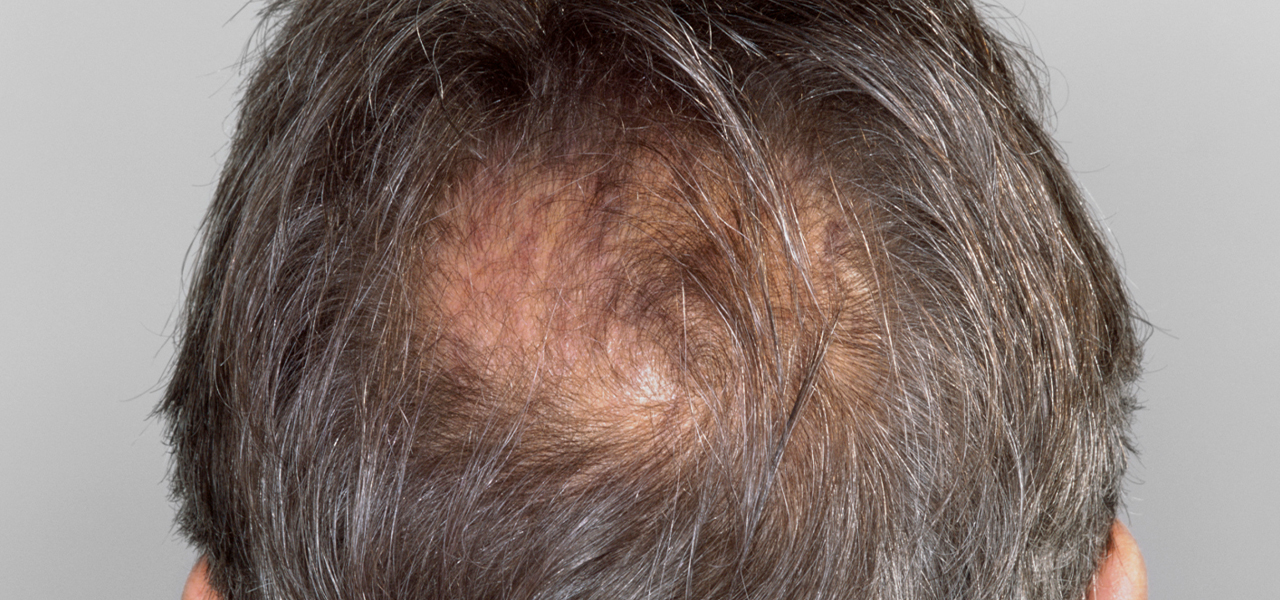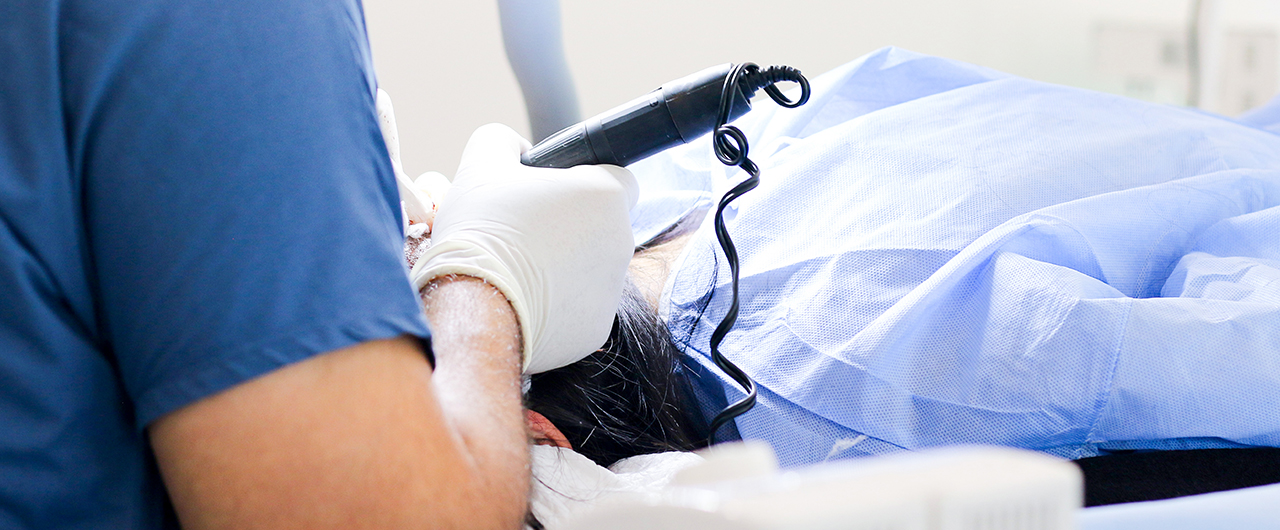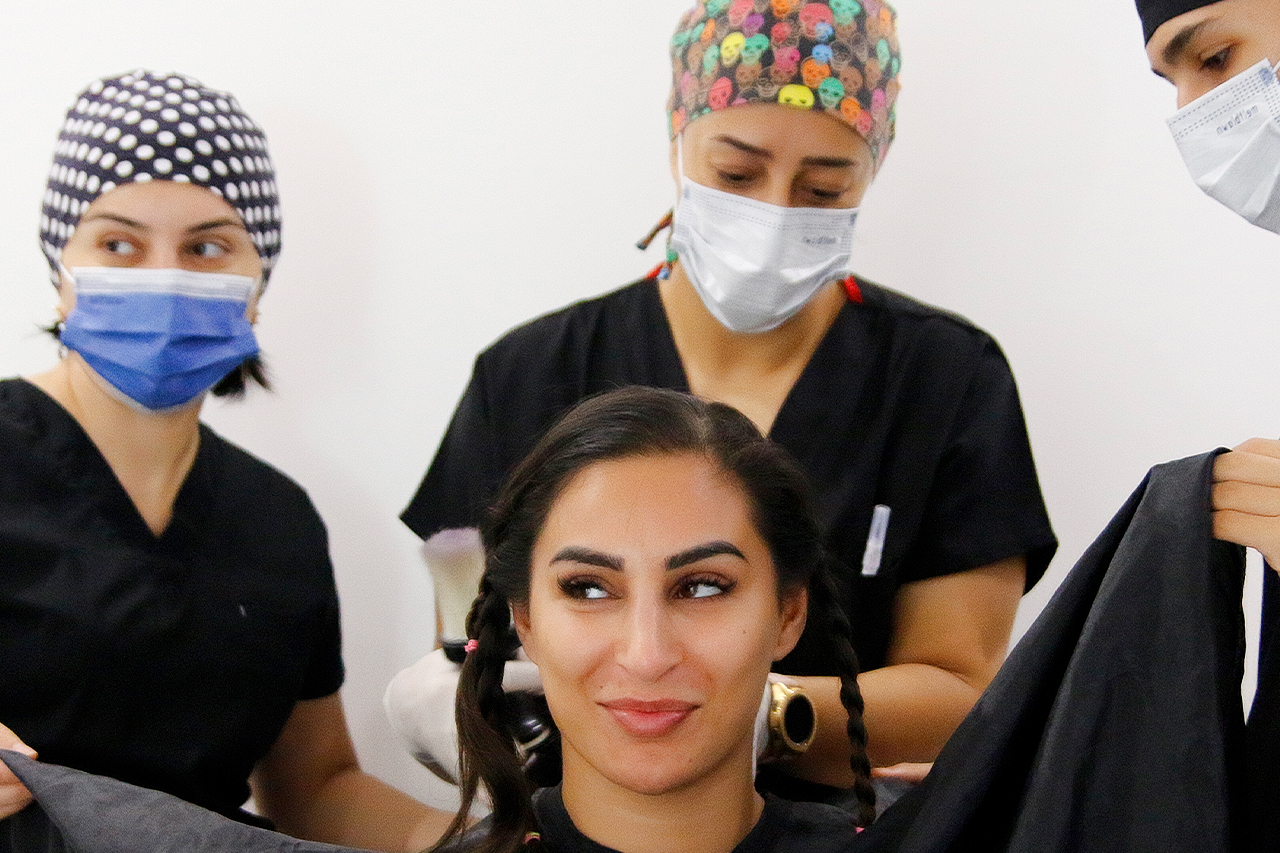1. What is Scalp Micropigmentation?
Scalp Micropigmentation uses microneedles to tattoo small dots on the scalp to simulate hair follicles. This scalp tattoo employs customised pigments to match the client’s hair colour. A portable instrument precisely applies pigments to the scalp, enabling the technician to produce natural-looking hair. Scalp Micropigmentation’s long-term outcomes might boost hair loss sufferers’ confidence.

How many treatment sessions are needed for Scalp Micropigmentation?
Scalp Micropigmentation treatment sessions depend on hair loss, skin type, and desired outcomes. Most folks require 2–4 sessions for results. The initial session lasts 4–6 hours, while successive ones last 2-4. Depending on skin healing and pigment retention, each treatment lasts 4–8 weeks.

Is Micropigmentation better than hair transplant?
Scalp Micropigmentation and hair transplants treat distinct forms of hair loss.
Scalp Micropigmentation is a non-invasive cosmetic tattoo that gives the illusion of a shaved head or thicker hair. Those who have lost their hair and want a low-maintenance, natural-looking alternative might consider it.
Yet, hair transplant surgery includes transplanting hair follicles from a donor location to a recipient area with hair loss. Those with enough donor hair and a long-term hair loss treatment might consider it.
Both methods have pros and cons, and the optimal choice depends on the individual’s hair loss pattern, donor hair availability, and desired result. To choose the finest alternative, contact a specialist.
How do you maintain Scalp Micropigmentation?
These methods will prolong Scalp Micropigmentation (SMP):
- Wear a helmet or use SPF 30 sunscreen to shield your head from the sun.
- Avoid sulphate and alcohol-containing hair products.
- Wash your scalp with mild, pH-balanced shampoo and conditioner.
- Scratching or picking the treated area may fade or blur the pigments.
- Avoid chlorinated water and hot tubs for four weeks following the treatment.
- To preserve SMP look, schedule touch-ups every several years.

What to expect after Micropigmentation on scalp?
Following Scalp Micropigmentation, the treated region may be red and swollen for a few days. The treated area may initially seem darker, but it should fade to the correct shade within a week or two. Scabbing and flaking are common during healing and should go away within a few days. Follow your practitioner’s aftercare guidelines to recover and maintain results.
What are the advantages of Scalp Micropigmentation in Turkey?
Turkey offers various benefits for Scalp Micropigmentation, such as:
- Scalp Micropigmentation is more cost-effective in Turkey than it is in other nations like the US or the UK because of the lower cost.
- Practitioners with knowledge and expertise: Scalp Micropigmentation is a field in which Turkey is home to several professionals with experience and expertise.
- Contemporary facilities: The most cutting-edge technology and Scalp Micropigmentation equipment are available in numerous Turkish clinics’ sophisticated facilities.
- A variety of methods are available in Turkey, including the pointillism technique, which may provide an outcome that seems more natural.
- Opportunities for tourism: Turkey is a well-liked holiday spot with a variety of lovely places to see, making it the perfect site to combine Scalp Micropigmentation therapy with a restful break.
What are the Scalp Micropigmentation options in Turkey?
In Turkey, there are several Scalp Micropigmentation choices, including:
- The most popular approach is standard Scalp Micropigmentation, which involves painting pigments on the scalp to simulate hair follicles.
- Long Hair Scalp Micropigmentation: This treatment is appropriate for those who have longer hair and want to maintain it that way. It entails blending colours with the natural hair by putting them to the scalp.
- Scar camouflage is an alternative for those who want to cover up scalp scars. To make the damaged region match in with the surrounding skin, colours must be applied to it.
- Density treatment: For those with thinning hair who want to make it seem thicker. In order to boost the general density of the hair, pigments are applied to the scalp.

Who is a good candidate for Scalp Micropigmentation?
Those who are good candidates for Scalp Micropigmentation include those who:
- Are you experiencing hair loss or baldness, including male and female pattern baldness?
- Scars from past hair transplant procedures or traumas on their scalp
- Have alopecia or thinning hair and want a non-invasive, non-surgical hair loss solution?
- Are unwilling or unable to finance hair transplant surgery
- Seeking a low-maintenance, long-lasting hair loss solution?
How is Scalp Micropigmentation performed?
A professional practitioner employs a specific tattooing method to implant microscopic spots of pigment into the scalp, giving the impression of hair follicles. A tiny portable instrument or a digital tattoo machine with a sterile, single-use needle is commonly used in the operation. The pigment used in the treatment is often a customised ink designed to match the client’s natural hair colour and skin tone. Depending on the breadth of the treatment region and the desired result, the total operation might take several hours.
.

How long does Scalp Micropigmentation take in Turkey?
The number of Scalp Micropigmentation sessions and total treatment duration in Turkey is determined by various variables. These include the level of hair loss, the density, and thickness of the hair, the pattern, and colour of the SMP, and the individual’s skin and hair type. A complete SMP treatment often takes 2 to 4 sessions, each lasting 2 to 4 hours. The overall treatment period, spread out across numerous sessions, might vary from 4 to 16 hours.
Our qualified and experienced SMP practitioner in Turkey will be able to offer a more exact estimate of treatment duration and session count for your unique situation.
How long does Scalp Micropigmentation last?
Scalp Micropigmentation is a semi-permanent cosmetic technique that deposits microscopic, specific pigments into the scalp to make hair seem thicker or cover baldness. The effects’ duration depends on the pigments’ quality, the treatment’s depth, and the patient’s skin type and lifestyle.
Scalp Micropigmentation typically lasts 2–5 years, however some individuals have claimed 8-year results. Sunlight, hair products, and skin regeneration may erase the procedure’s pigments. Scalp Micropigmentation pigments fade gradually, unlike regular tattoos, which change colour or distort.
Proper scalp care and avoiding hazardous factors might prolong the therapy. .
Scalp Micropigmentation outcomes vary by person, and some may need touch-ups to maintain coverage or depth. A qualified and experienced Scalp Micropigmentation practitioner in Turkey can give more thorough information on the projected duration of your results and the correct care and maintenance needed to enhance treatment lifespan.
What should you do after Scalp Micropigmentation?
To get the greatest results from Scalp Micropigmentation, take care of your scalp. After the operation, perform these:
- During four weeks after the surgery, avoid direct sunlight, tanning beds, and sunbathing. Sunshine fades pigment, so shield your scalp from direct sunlight.
- After treatment, keep your scalp dry. Avoid sweating, swimming, or getting your scalp wet as it might slow recovery.
- Employ a light shampoo to clean your scalp and avoid harsh chemicals.
- Avoid scratching or rubbing your scalp to prevent premature pigment loss.
- During the first two weeks after treatment, don’t wear caps or other headgear that rubs your scalp.
- Attend your follow-up sessions since your practitioner may need to touch up the pigment.
To get the greatest results from Scalp Micropigmentation, take care of your scalp and follow your practitioner’s aftercare recommendations.
What is the difference between Scalp Micropigmentation vs tattoos?
Tattoos and Scalp Micropigmentation employ ink and needles to produce images on the skin. Yet, the two methods vary significantly.
- Scalp Micropigmentation is scalp-specific cosmetic tattooing. A scalp tattoo machine makes tiny, precise dots. These dots resemble hair follicles and provide the impression of a full head of hair. Scalp Micropigmentation ink is supposed to fade gently and match the client’s hair and skin colour.
- Tattoos are more complex and use a range of colours and methods. Tattoos may be put anywhere on the body for self-expression or creativity. Tattoo ink is permanent and vivid, unlike Scalp Micropigmentation ink.
- Ink depth distinguishes Scalp Micropigmentation from tattoos. Scalp Micropigmentation involves shallow ink placement. This simulates genuine hair follicles. Tattoos have deeper ink, which may elevate the skin over time.
- Scalp Micropigmentation and tattoos have different aims, methods, and results.
Will Scalp Micropigmentation change colour like tattoos?
Microneedles apply small, layered spots of colour to the scalp in Scalp Micropigmentation (SMP). SMP pigments are created for the scalp, unlike tattoo pigments. Hence, SMP is less prone to alter colour than regular tattoos.
Traditional tattoos are deeper in the skin and utilise various ink compositions that might change colour or fade over time depending on sunlight exposure and ink quality. SMP pigments are implanted in the skin’s top layers to simulate hair follicles. The pigment type, process, skin type, and lifestyle behaviours affect the pace of fading.
Protecting the scalp from sunshine and avoiding harsh hair treatments may help SMP retain its colour. Maintaining the SMP’s look may need regular touch-ups.
Can Scalp Micropigmentation be removed?
SMP is a semi-permanent cosmetic tattoo that lasts many years. If results are unsatisfactory or a response occurs, a person may desire to remove or replace the SMP.
SMP removal procedures are harder than tattoo removal. Laser, saline, and excision may eradicate SMP. Lasers break down scalp ink with high-intensity light. Saline solution tattooing lifts pigment from SMP without lasers. Excision removes pigmented skin surgically.
SMP removal is painful, time-consuming, and may fail. SMP removal may also scar or impact skin texture.
Hence, before getting SMP, you should carefully assess if it’s suitable for you and find an experienced and skilled SMP practitioner to reduce the chance of problems.
Who should avoid Scalp Micropigmentation?
Scalp Micropigmentation is typically safe and effective, however some people may prefer to avoid it. These:
Scalp Micropigmentation is not suggested for pregnant or breastfeeding women. The procedure’s consequences on a growing foetus or breastfed newborn are unknown due to a lack of study.
Scalp Micropigmentation may not be safe for those with blood clotting issues like haemophilia. If you have a clotting issue, the operation might cause bleeding and bruises.
Individuals with keloid scarring: After an accident or surgery, keloids grow thick, elevated scars. If you have keloid scarring, Scalp Micropigmentation may cause further scarring.
People with unreasonable expectations: Lastly, Scalp Micropigmentation requires realistic expectations. The technique cannot encourage hair growth, but it may make hair seem thicker and fuller. Expecting a full head of hair following the operation may be disappointing.
What should be done before Scalp Micropigmentation?
Prepare for Scalp Micropigmentation:
- Research the process and clinic. To prepare, read reviews, testimonies, and before-and-after photos.
- Consultation: Discuss your objectives with the clinic. The practitioner will evaluate your scalp and hair to select the optimal treatment.
- Medication: Tell the doctor about your prescriptions. Stopping blood thinners may be necessary before the operation.
- Shave the scalp before the treatment. The practitioner may perform this or ask you to.
- Sunburn or tanned skin might hinder pigment absorption, therefore avoid sun exposure for at least a week before the treatment.
- Hydrate: Drink plenty of water before the operation to hydrate your scalp.
- Rest: Get enough sleep the night before the surgery to relax.
